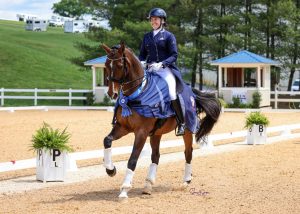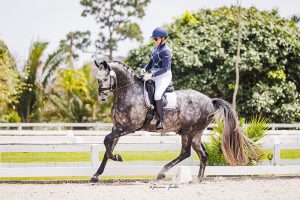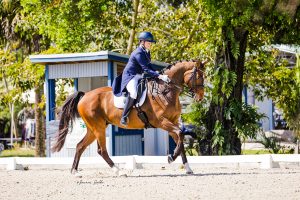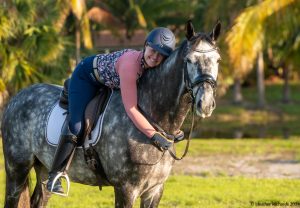Walking The Walk
 The Virginia Horse Center in Lexington, Virginia, is a great gift of a venue for so many reasons: It’s super easy to get to, being at an intersection of two major highways; it’s in a proper town with a million hotels and restaurants and a cute downtown; and the board that runs it has poured resources into it, redoing the footing in nearly all of the arenas to international-grade surfaces for the English disciplines.
The Virginia Horse Center in Lexington, Virginia, is a great gift of a venue for so many reasons: It’s super easy to get to, being at an intersection of two major highways; it’s in a proper town with a million hotels and restaurants and a cute downtown; and the board that runs it has poured resources into it, redoing the footing in nearly all of the arenas to international-grade surfaces for the English disciplines.
It’s also huge, which means that they have the ability to hold multiple different disciplines on the same weekend. Such is the Mid-Atlantic Dressage Festival and Lexington CDI3* (MADFest, for short), held in May alongside the Keswick Horse Show. International dressage, national dressage, hunters and jumpers, all together.
I freaking love it.
Read the rest at The Chronicle of the Horse!
 Greetings from Virginia. My team, the horses and I are settled back in after a productive Florida season, and I’m ramping back into the mayhem of spring horse shows, teaching clinics and generally running all over the place at Mach 2 with my hair on fire. It’s not left time for … well, anything else, really, but certainly not for a lot of contemplation. But there’s also not been a lot to contemplate. I’m an ambitious rider trying to make the Big Time, but where I currently am on that path with the group of horses I have right now is a place that is well within my comfort zone. The boys are ages 6, 7 and 9, and I have done those years a LOT.
Greetings from Virginia. My team, the horses and I are settled back in after a productive Florida season, and I’m ramping back into the mayhem of spring horse shows, teaching clinics and generally running all over the place at Mach 2 with my hair on fire. It’s not left time for … well, anything else, really, but certainly not for a lot of contemplation. But there’s also not been a lot to contemplate. I’m an ambitious rider trying to make the Big Time, but where I currently am on that path with the group of horses I have right now is a place that is well within my comfort zone. The boys are ages 6, 7 and 9, and I have done those years a LOT. A few weeks ago, a friend of mine took his young, promising FEI horse to a big indoor show—their first after a season of success in outdoor competition. The Grand Prix went well. But in the freestyle, his poor horse was overwhelmed by the environment and utterly lost the plot. My friend had to pilot a bomb around, so the score was a bit grim. A Facebook page I follow had posted about it, and with my heart in my throat, I clicked on the comments section.
A few weeks ago, a friend of mine took his young, promising FEI horse to a big indoor show—their first after a season of success in outdoor competition. The Grand Prix went well. But in the freestyle, his poor horse was overwhelmed by the environment and utterly lost the plot. My friend had to pilot a bomb around, so the score was a bit grim. A Facebook page I follow had posted about it, and with my heart in my throat, I clicked on the comments section.
 So, I’m 40 now. It doesn’t look like I thought it would as a kid.
So, I’m 40 now. It doesn’t look like I thought it would as a kid. My last blog was about our
My last blog was about our  Man, oh man, what a triumph it was for us at the Paris Paralympics! We all knew it was going to be an exciting Games for USA Para Dressage, but it ain’t over ’til it’s over. And Becca Hart, Fiona Howard, Roxie Trunnell and Kate Shoemaker came, saw and conquered, and took home a mountain of medals for equestrian sports in Paris.
Man, oh man, what a triumph it was for us at the Paris Paralympics! We all knew it was going to be an exciting Games for USA Para Dressage, but it ain’t over ’til it’s over. And Becca Hart, Fiona Howard, Roxie Trunnell and Kate Shoemaker came, saw and conquered, and took home a mountain of medals for equestrian sports in Paris. Over the years, through breeding my own and selling them, through the help of some incredible people, through a few really creative loans, and through a HECK of a lot of hard work, I’ve managed to own many of my own horses. Owning my own means I answer to no one, and it means that when they go right, the proceeds of their sales funds the next group. My goal is that each one I train and, as I’ve yet to find my Team mount, sell leads to the purchase of two more young horses to bring along; I’m ok when the sale of one leads to the purchase of one.
Over the years, through breeding my own and selling them, through the help of some incredible people, through a few really creative loans, and through a HECK of a lot of hard work, I’ve managed to own many of my own horses. Owning my own means I answer to no one, and it means that when they go right, the proceeds of their sales funds the next group. My goal is that each one I train and, as I’ve yet to find my Team mount, sell leads to the purchase of two more young horses to bring along; I’m ok when the sale of one leads to the purchase of one.